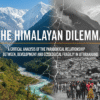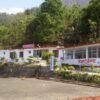Binsar wildlife sanctuary is a national park in Almora district of the Kumaon region of Uttarakhand. Binsar offers one of the most beautiful scenic places in Kumaon. It is located at an elevation of 2420 meters. It offers majestic views of Himalayan peaks such as Chaukhamba, Nanda Kot, Panchachuki, Kedarnath and Nanda Devi. Binsar offers 300 Km of majestic and panoramic views of Himalayan peaks from Binsar Zero Point. Every day, hundreds of tourists visit Binsar zero point to enjoy the beautiful views of the great Himalayan ranges and famous peaks of Uttarakhand.
It is a compact hill town encircled by Binsar Wildlife Sanctuary, which is the habitat of some rare animal species. If you are an adventure lover, hiker, or camper then you are going to love this place. There is a lot to explore in Binsar wildlife sanctuary.
Binsar hills are commonly known as Jhani Dhar which offers amazing views of the nearby places like Almora and other Himalayan peaks and mountains. It is a perfect place for bird watching, jungle trekking, photography and camping.
Read our details guide on how to reach Binsar.
Binsar History
Binsar town was the summer capital of the Chand Dynasty, which ruled the Kumaon region from the 11th to 18th century A.D. There is an ancient Shiva temple which is very famous in Binsar known as Binsar Mahadev. This temple was built in the 16th century A.D. by Raja Kalyan Chand of the Chand dynasty.
It is also renowned as the location of a mythological war between the King of Binsar and Golu Devta. It is believed that Golu Devta was beheaded.
In the olden days, people came from far-flung villages via treks and paths they created by themselves to pay homage to Binsar Mahadev.
Mythology about Binsar
The name Binsar is derived from 2 words Bin and Sar which means without head. Some historians state that once there was a battle held between Golu Devta and the King of Binsar.
It is believed that Golu Devta was beheaded and his head fell at Kaparkahan and his trunk at Gairad Dana Golu.
Why visit Binsar
From beautiful hills, beautiful orchards, meadows and mesmerizing Himalayan peaks and mountains. Travelers can also visit Jageshwar Temple, which is one of the 12 Jyotirlingas located about 50 Km from Binsar town. You can see different species of birds here, it is a perfect place for bird watchers.
Binsar Wildlife Sanctuary
Binsar Wildlife Sanctuary was set up in the year 1988, the whole area is spread over 45.59 sq Km and it is rich in flora and fauna. Binsar Wildlife Sanctuary has been declared an Important Bird Area by BirdLife International. There are more than 200 species of birds in the sanctuary, including Blackbirds, Laughing Trush, Kalij Pheasant, Monal, Parakeets, Nuthatches and Forktail.
The dense forests of Binsar Wildlife Sanctuary are the home of 200 bird species and animals Barking deer, fox, musk deer, langur, porcupine, flying squirrel, chital, jungle cat, Himalayan bear, etc.
Binsar Wildlife Sanctuary Entry Ticket Price
The entry ticket price to Binsar Wildlife Sanctuary is Rs. 40 per person and Rs. 50 for cars and other vehicles. The ticket will be collected at the entry point of Binsar Sanctuary.
Staying in Binsar
Binsar is a hill station and if we compare Binsar with the other hill stations of Uttarakhand, it is a less popular and known tourist destination. So there are not so big and premium hotels and restaurants. For staying, there are a handful of accommodation options available at Binsar.
However, you can travel to Almora which is just 33 Km from Binsar where you can find a wide range of staying options.
Binsar Food Guide
There are no restaurants in Binsar you can get a few restaurants on the way to Binsar – Almora highway. You will get pahadi kumaoni food items at those resorts, and some offer Chinese food and Almora’s famous sweet Balmithai.
Binsar Travel Tips
- Binsar can be visited any time of the year, the best time to visit Binsar is from April to June and from September to November
- Avoid visiting Binsar during monsoon season, you can face road blockage and landslides, and the route becomes slippery.
- If you want to witness the crystal clear Himalayan views and other peaks, then December and February months are best to visit Binsar.
- If you travel during the peak season, then you could face problems finding accommodation and who loves crowds?



